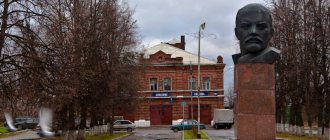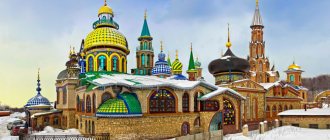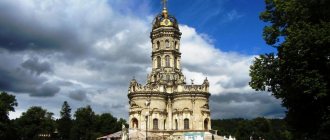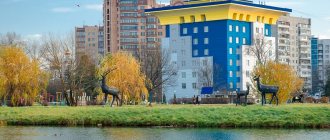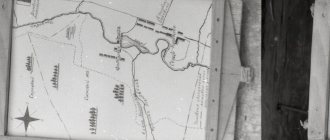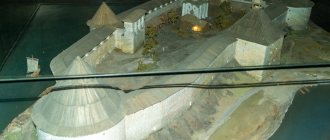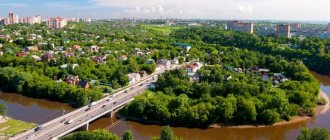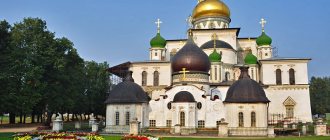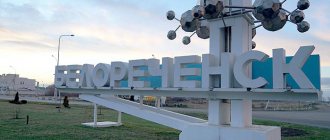Sights of Podolsk - what to see? Podolsk is the administrative center of the Moscow region, located just 15 km from the outskirts of Moscow, and is a satellite of the capital.
The history of Podolsk begins in the Middle Ages, when the Podolsk lands adjoined the Danilov Monastery. The village began to grow very quickly on these lands, and industry developed as the population grew. The Serpukhovsky truck ran through the village, this is the road along which local residents transported the grain they grew to Moscow. Due to their territorial proximity to Belokamennaya, residents began to drive cabs and open roadside taverns, inns, and began the development of industry in this region.
The city is built on the Pakhva River, which is a tributary of the Moscow River. Therefore, from ancient times, rich merchants and townspeople located their estates on the high bank of Pakhva, and poorer peasants built houses on the low bank, so their homes were often flooded.
Why Podolsk is popular
In the 18th century, a stone bridge was built across the river and traffic through the village increased, and trade routes to Moscow were established. In the same century, by order of Catherine 2, the village was given the status of a city, so the queen is highly revered here and even a monument to her was erected in the city. During the wars of 1812 and 1941, Podolsk had strategic defensive importance for Moscow.
Podolsk is popular both for country holidays for Muscovites and for other tourists. In addition to the advantage of its proximity to the capital, the city has an interesting history and many architectural and historical monuments.
At first glance, Podolsk gives the impression of a gray city, this is true, because we should not forget that this is a highly industrialized part of the region. However, having dug into history and visiting attractions in the form of ancient churches, estates, monuments, fountains, you will see the city for yourself from a different side. Let's consider the main attractions of Podolsk and its surroundings with a detailed description.
Presentation for the class hour “My city Podolsk” material on the topic
Slide 1
My city is Podolsk.
Slide 2
City `s history. The village of Podol (Podol-Pakhra) has been known since 1627-28 as the patrimony of the Moscow Danilov Monastery. The name is formed by the term podol (plain, floodplain, terrace above the floodplain), which reflected the location of the village. The city of Podolsk grew out of the village of Podol, known since the 17th century as a small settlement on the banks of the Pakhra River. According to surviving sources, it is known that about 270 people lived in the settlement and there were about 30 households in the settlement. Mention is made of the small wooden Church of the Resurrection of Christ, which later became white-stone. Residents of Podol were engaged in gardening, arable farming, and transportation, which was considered prestigious. Trade developed in Podol, they traded in flaxseed oil and canvas, there were inns and taverns.
Slide 3
In October 1781, Catherine the Second issued a decree in which it was ordered to rename the village Podolsk and open the Podolsk district. Among the local residents there is a witty legend, passed on to this day, that while passing through the village, Queen Catherine soaked the hem of her dress and that’s where the name Podol came from. Podolsk is surrounded by picturesque plains and vast valleys, perhaps this gave rise to the beautiful and poetic name Podol and Podolsk.
Slide 4
In the 19th century, the main occupation of the residents was trade, transportation and extraction of white stone and rubble. Beautiful houses were built from Podolsk white stone in the Moscow region and Moscow. White Podolsk stone was called local Podolsk marble. The famous Church of the Sign was built from this marble in Dubrovitsy. The economic development of Podolsk in the 19th century accelerated the construction of the Brest-Litovsk (Warsaw) road in 1844-47, and the railway in 1866. In 1900, the American JSC Singer Company began construction of a plant in Podolsk for the assembly of sewing machines and the production of parts for them. The first cars were produced in 1903.
Slide 5
Podolsk is a participant in military events. In September 1812, the city was occupied for a short time by French troops, who caused significant damage to it. In memory of these events, the Trinity Cathedral was erected in the city (now located in the city center, opposite the Karl Marx Palace of Culture).
Slide 6
The outbreak of the Civil War forced the Soviet government to resume military production. Since many military factories in Russia were occupied by the White Guards, it was decided to build a new cartridge factory in Podolsk. He occupied part of the projectile. Since the fall of 1919, it began to produce cartridges and remake foreign cartridges. On May 2, 1919, the Podolsk Steam Locomotive Repair Plant (the future Ordzhonikidze Plant) was opened in Podolsk, which was deployed on the territory of a cable and copper rolling plant.
Slide 7
During the Great Patriotic War, Podolsk was a front-line city. Although the city was bombed little, several German air raids were carried out, which tried to hit two objects: the bridge over the Pakhra River and the bank building on Strelka (now Lenin Square). Significant assistance to the front was provided by Podolsk industrial enterprises, which during the Great Patriotic War transferred all capacities from the production of civilian products to production for the defense industry: they produced ammunition, repaired tanks and other military equipment. The Ordzhonikidze Machine-Building Plant produced armored hulls for T-40 tanks and Il-2 attack aircraft. By November 1941, the plant was completely evacuated from Podolsk. In its place, a numbered plant was opened for the production of anti-tank hedgehogs, shovels, armored locomotives, and in 1942, also evacuated from Taganrog, which continued boiler production in the city.. On January 1, 1942, to the soldiers of the 43rd Army by employees of the S. Ordzhonikidze Machine-Building Plant The famous armored train "Podolsky Rabochiy" was transferred. In 1939 - 1940, artillery and infantry schools were created in Podolsk, in which more than 3 thousand cadets studied. On October 5, 1941, Podolsk cadets were alerted and defended Maloyaroslavets for several days during fierce battles.
Slide 8
Culture of the city of Podolsk Temples and churches. Trinity Cathedral. Trinity Cathedral, built in 1819 - 1832 in honor of the victory in the Patriotic War of 1812 and is a five-domed cathedral in the Empire style with a three-nave refectory and a three-tier bell tower. Among the churches in the southern Moscow region, the Trinity Cathedral is the only one with a five-domed top. The architect of the cathedral is Osip Ivanovich Bove, famous for the reconstruction of Moscow after the fire of 1812. Trinity Cathedral was created as a compositional center of urban development, so a high hill above the Pakhra River was chosen for its construction. Trinity Cathedral has its own shrines: this is the Jerusalem Icon of the Mother of God, revered by Podolsk residents for delivering the city from cholera in 1866, two relics with particles of the relics of 140 saints, an icon of the new martyrs of Podolsk. During the years of Soviet power, Trinity Cathedral was the only functioning city cathedral in the Moscow region.
Slide 9
One of the oldest churches in Podolsk is the Church of the Resurrection of the Word (or simply the Resurrection Church) on Krasnaya Street, which is mentioned in the scribe books of 1627 - 1628, when the village of Podol, which was the patrimony of the Moscow Danilov Monastery, was located on the territory of the modern city. The first church was wooden, which caused a fire in 1722. In the middle of the 19th century, the church was repaired and an independent parish was restored. But with the establishment of Soviet power, church property was confiscated, and in March 1929 the Resurrection Church was closed. Subsequently, the church was significantly destroyed (including the destruction of the bell tower), and it was turned into a workshop for the production of tombstones. An industrial technical school was built in the adjacent cemetery, where those who died from the cholera epidemic of 1848 and closed in 1924 were buried. Subsequently, the church was used for other economic purposes. The first divine liturgy took place only in 1995. Between 1995 and 1999, the Church of the Resurrection was actually revived.
Slide 10
Church of the Sign In 1690-1704. The Znamenskaya Church, remarkable in its architecture, was built. The temple builder, on the recommendation of Peter I, invited an Italian architect. His name is still not known. The church was built by foreign craftsmen and Russian serfs. The building was built from limestone quarried nearby, on the banks of the Pakhra. In 1697, when the church was ready, the location for the church was chosen surprisingly well - on a hill, where the Desna merges with the Pakhra. The temple was consecrated by Metropolitan Stefan (Yavorsky) on February 1704 in the presence of Peter I, Tsarevich Alexei and many secular and clergy. The king brought a rich gift: expensive church utensils. In 1848-1850 carried out the restoration of the Church of the Sign with funds allocated from the treasury by order of Emperor Nicholas I. In the 1930s. The Church of the Sign was closed. In 1932, the bell tower was blown up. The temple fell into disrepair. In 1947, the temple building housed the warehouses of the All-Union Scientific Research Institute of Animal Husbandry. The first Liturgy in the last 60 years was celebrated on October 14, 1990. It was led by Bishop Gregory of Mozhaisk. Complex restoration work is being carried out in the temple. The church is included in the UNESCO World Heritage List.
Slide 11
Estates. One of the famous attractions of the city is the former Ivanovskoye estate, which currently houses the Museum of Local Lore and the Museum of Professional Education of Russia. For the first time, Ivanovo as a patrimonial property was mentioned in the scribe books of 1627. At the end of the 17th century, the estate belonged to the okolnik Ivan Ivanovich Golovin and his heirs, in the second half of the 18th century - to Field Marshal Mikhail Fedotovich Kamensky. At the end of the 18th century, Ivanovskoye came into the possession of the senator, cousin of Lev Nikolaevich Tolstoy, Count Fyodor Andreevich Tolstoy. It was by his order that the artistic complex of the estate was created. After the death of Fyodor Tolstoy, the estate passed to the Count, Governor-General of Finland (1823), Moscow (1848 - 1859) Arseniy Andreevich Zakrevsky, who carried out the reconstruction of Ivanovsky. Subsequently, Ivanovskoye was the property of Countess Agrafena Fedorovna Zakrevskaya, Countess Sofia Vasilievna Keller and the Bakhrushin family, who in 1916 donated the estate to the Moscow city government for the establishment of a medical and educational institution for orphans.
Slide 12
The Golitsyn estate in Dubrovitsy is located in the village of Dubrovitsy, Podolsky district. The history of this place is inextricably linked with such famous people as Prince I. A. Golitsyn, boyar I. V. Morozov, Peter the Great. The magnificent manor in Dubrovitsy was rebuilt a lot by its owners over several centuries and over time moved from the Baroque style to classicism. The main staircase of the estate is decorated with stone lions, and a wide carriage road leads to the central entrance.
Slide 13
Urban sculptures. Lenin monument . Sculptor - Z. I. Azgur, architect - L. P. Zemskov. Installed on the central square of the city, named in his honor, on October 29, 1958. The leader of the October Socialist Revolution visited the city in July 1900. Earlier, in May 1898, the Ulyanov family settled in Podolsk. During the days spent in Podolsk, Lenin thought through the complex issues of transporting the first all-Russian illegal Marxist newspaper from abroad to Russia, illegal appearances and addresses were planned (all that ensured the publication of Iskra).
Slide 14
Monument to the Cadets of Podolsk Military Schools, who, together with units of the 43rd Army, held back the onslaught of Nazi troops and helped gain time to bring up reserves to Moscow. Authors: sculptors - Yu. Rychkov and A. Myamlin, architects - L. Zemskov and L. Skorb. Opened on May 7, 1975 at the intersection of Kirova Street, Parkovaya Street and Archive Proezd. The stainless steel monument depicts three cadets (two of them are holding machine guns, the third is holding his left hand raised), in the upper part is a star, and behind the monument is a diagram of the combat operations of Podolsk cadets. To the right of the monument is the accompanying inscription: “Dedicated to the courage, perseverance, and immortal feat of Podolsk cadets,” and to the left on the earthen parapet is a long-barreled cannon.
Slide 15
Architectural and sculptural ensemble on the 50th Anniversary of October Square, dedicated to the Great Patriotic War of 1941-1945. Authors: Y. Lyubimov and L. Zemskov. Installed in November 1971. Carved on a large concrete slab are Soviet soldiers eager to fight with grenades and machine guns, as well as the words: “To the Podolsk heroes who defended their Motherland, honor and freedom with their lives.” In 2010, the ensemble was reconstructed: to the right of the slab with carved Soviet soldiers and the stele, a memorial complex to the military and labor exploits of Podolsk residents during the Great Patriotic War was opened. The eternal flame was placed in front of the reconstructed stele. In addition, the complex included a monument to fellow countrymen who died while performing international duty in Afghanistan and combat missions in Chechnya (sculptor - Honored Artist of Russia A. A. Rozhnikov, architect M. V. Tikhomirov). At the same time, after an appeal from the council of war veterans, labor veterans, the Armed Forces and law enforcement agencies to the city administration, it was decided to call the square “Glory Square”
Slide 16
Monument-obelisk to the grenadiers of Miloradovich who fell on Podolsk land in 1812. Opened on October 2, 1912 to mark the 100th anniversary of the Patriotic War of 1812. During the years of Soviet power it was converted into a monument to Karl Marx, but was restored in 1995. Located on Cathedral Square in front of the Trinity Cathedral between Bolshaya Zelenovskaya, Fevralskaya and Revolutionary Avenue streets. Crowned with the Alexander coat of arms. There is a plaque on the monument: “September 22, 1812.” The Russians, under the command of General Miloradovich, fought all day between the villages. Voronov and Tarutin with Murat’s corps blocked the French’s path to the camp of the Russian army led by Kutuzov.”
Slide 17
Monument to Viktor Vasilyevich Talalikhin. Sculptor - Z. I. Azgur, architect - L. P. Zemskov. It was opened on May 9, 1960 with funds earned by Komsomol members. Located in the Central City Park named after. V. V. Talalikhina. The monument is a bust of the hero on a granite pedestal. On the pedestal there is the inscription “To Viktor Talilikhin” and a metal plaque with his biography and description of the feat.
Slide 18
Monument to Mikhail Illarionovich Kutuzov. Sculptor - Udalova S. M., architects - Lyubarskaya O. G., Kudrina S. V. Opened in 1995. Located in the Kutuzovo microdistrict at the intersection of Sosnovaya and Borodinskaya streets. It is a 22-meter composition, on top of which is a sculpture of Archangel Michael made of stainless steel.
Slide 19
Monument to Catherine II. Sculptor - Rozhnikov A. A., architect - Tikhomirov M. V. Opened on September 14, 2008. Located in Catherine Square near Vokzalnaya Square. The monument depicts the Empress at the moment of signing the Decree of October 5, 1781, where the entry appears: “... we most graciously command that the economic village of Podol be renamed a city...”
Slide 20
Monument to Alexander Sergeevich Pushkin. Author: Viktor Mikhailovich Mikhailov. Opened on June 6, 1999 and installed on the 200th anniversary of the poet’s birth. Located in the park to the right of the Podolsk Administration building (other places for installation were proposed: the Ivanovskoye estate, the park in front of the Lepse Palace of Culture, the square near the old city committee). The monument is a bust of the poet made of red-brown granite, which stands on a column of black granite. The position of the poet's hands is close to the portrait of Kiprensky, with the right hand placed on the shoulder and the left on the bust. On the pedestal there is an inscription: “My friend, let us dedicate our souls to our homeland with wonderful impulses.”
Slide 21
Bronze sculpture "Justice". Author - D. V. Kukkolos. Installed on December 23, 2005 on the territory of the new building of the Podolsk City Court. The Podolsk goddess of justice has classical attributes (scales, sword, blindfold), and also holds in her right hand a shield with the image of the coat of arms of Russia
Slide 22
Flag and coat of arms of the city. The current flag of Podolsk was approved on June 30, 2006. The authors of the flag are Konstantin Mochenov (flag idea), Kirill Perekhodenko (symbolism rationale), Galina Rusanova (artist and computer designer). The flag was designed taking into account the coat of arms created on the basis of the historical coat of arms of the district city of Podolsk, Moscow province, approved on March 16, 1883. The flag of the urban district of Podolsk is a rectangular panel with a width to length ratio of 2:3, divided into two parts: a smaller, red one, located in the upper part of the panel, occupies 1/5 of the length and is large, blue, bearing the image of two gold picks placed crosswise. The current coat of arms of Podolsk was approved on December 24, 2004. The historical coat of arms, Supremely approved on December 20, 1781, is taken as the basis of the coat of arms. In the azure (blue, light blue) shield there are two golden pickaxes placed crosswise.
Slide 23
Objects and colors on the coat of arms and flag of Podolsk symbolize the following: Kirks - the industrial orientation and historical type of activity of the city residents. Gold is a symbol of strength, strength, justice and independence. Azure (blue, light blue) is a symbol of honor, sincerity, virtue. Red is a symbol of belonging to the Moscow region and affirms the triumph of labor, courage, and the power of life.
Slide 24
Sister cities and partners Since 1996, Podolsk has been a member of the international association “Sister Cities”, since then taking an active part in various cooperation programs with foreign countries. Amstetten (Austria), Bar (Montenegro), Bila Tserkva (Ukraine), Borisov (Belarus), Balti (Moldova), Vanadzor (Armenia), Warmian-Masurian Voivodeship (Poland), Kavarna (Bulgaria), Kladno (Czech Republic), Ohrid Macedonia), Kvemo-Kartli region (Georgia), Saint-Ouen (France), Sukhumi (Abkhazia), Trier-Land district (Germany), Hengyang (China), Chernivtsi (Ukraine), Shumen (Bulgaria), Engels (Russia) .
Slide 25
Photo of the old city. Bolshaya Serpukhovskaya Street Bronnitskaya Street (second checkpoints of the Kalinin plant)
Slide 26
Wooden bridge over the Pakhra River (view from Krasnaya Gorka) Railway bridge over the Pakhra River
Slide 27
Zemskaya Hospital Zastava Varshavskoe Highway
Slide 28
Red Rows Manor Ivanovskoe
What to see in Podolsk
Architectural sights of Podolsk
- The Dubrovitsy estate is an architectural monument of Podolsk; its construction dates back to the 17th century. The main construction work was carried out by Prince Golitsyn, in the Baroque style. The estate is located on the banks of the Pakhra River, framed by a picturesque park.
In the 20th century, the estate housed a museum of noble life, but soon all the exhibitions and furniture were taken out and transferred to Moscow museums, so now there is nothing left inside except for the paintings on the walls from that historical time. Today you can admire the Dubrovitsy Estate only from the outside.
One of the significant historical features of the estate is the Church of the Sign of the Lord, which dates back to the 12th-13th centuries, which you can read in more detail below.
- The Krasnoe estate is located in the vicinity of Podolsk, in the village of Krasnoe. The foundation of the Estate dates back to the 18th century; during its existence, the Estate has seen many owners. The most famous of them were the Saltykov princes, who acquired it in the 19th century. During the reign of which, many additional buildings were adjacent to the Estate. The Red Estate was framed by a luxurious park with ponds.
Today, the church built on the estate has been preserved, which still receives parishioners to this day. The remaining buildings have become very worn out and now the Estate, like the park, is abandoned and fairly overgrown. You can only see the building from the outside and visit the local church.
- The Ivanovskoye estate is located in the village of the same name, near Podolsk. The exact date of construction of the original estate has not been established, however, after it came into the possession of Count Tolstoy, a relative of the writer, significant construction work was carried out on the territory of the Estate. In addition to the main building, outbuildings and a theater were added here.
During Soviet times, the estate was occupied by officials, and later a hostel was located. At the moment, there are 2 museums on the territory of the Ivanoskoye estate, the main building houses the Museum of Vocational Education, and in the wing and garden pavilion there is a branch of the local history museum. A significant role was played by the church built on the territory of the estate, which still operates today.
- The Ostafyevo estate was built in the 18th century and became famous during the ownership of Count Sheremetyev, who was a great connoisseur of literary art. It was Count Sheremetyev who opened the Pushkin Museum on the territory of the estate, which operated until 1930. After a while, some of the exhibits were taken out and sold.
The museum managed to regain its status only after 50 long years; now it houses the thematic exhibition “The Museum We Lost,” and the exhibition “Cabinet of Medals” is located in the outbuilding.
- The Pleshcheyevo estate has changed many owners over its existence, the most popular of them being Fyodor Byakont and P.I. Tchaikovsky. The estate is located on the river bank with an adjacent park.
After the revolution, the buildings were used for various government needs. At the moment, only a few buildings of the estate have survived, which are used as residential buildings for some families.
- The Alexandrovo-Shchapovo estate is located in the village of the same name, near Podolsk. The first memories of the estate date back to the 17th century; at various times it was in the possession of the Morozovs, Grushevskys, and Arsenyevs. Over such a long period of life, the estate was overgrown with a large park with artificially created ponds, a new manor house, a parish school, a school for girls, an almshouse and the Church of the Assumption of the Virgin Mary, famous in the area.
The buildings have not been poorly preserved to this day; they are regularly reconstructed. On the territory of the estate there is now a museum of the history of the estate, a large library and even an organ hall. And the church is still open to all parishioners.
- The Palivanovo estate is located in the vicinity of Pavlovsk. A small village of the same name is located near the Pakhra River, and the estate itself is named after the first owners, the Polivanovs. The construction of the estate dates back to the 17th century, at the same time, a manor park was developed here and a wooden Annunciation Church was erected. After the War of 1812, the church was destroyed and a stone temple was erected in its place. Both the Estate and the Annunciation Church have survived to this day. This area is regularly visited by tourists in order to be transported back to the 17th-18th centuries of our history.
- The Rodnevo estate is a fairly recent building among local estates, dating back to the beginning of the 20th century. The first owners of the estate were a family of local bakers. There are many legends surrounding the building. During Soviet times, the building housed a sports center for Olympic training. Today the building is in dilapidated condition and requires reconstruction.
- The Vorobyovo estate also bears the name of its first owners and is located in a village near Podolsk. The estate was rebuilt under E. Tatishev in the 18th century, and in the 19th century a Temple was erected at the estate in honor of the Descent of the Holy Spirit. In Soviet times, the historical building underwent reconstruction; there was a rest house here; fortunately, nowadays the estate has been restored to its former historical appearance.
- The Slavic Kremlin is an unusual complex built in the Podolsk region in 2005.
This unusual architectural composition personifies the life of the people of ancient Rus'. Here there are buildings in the Old Russian style, ancient mills, stoves, household items and utensils. You can immerse yourself in the era of ancient and medieval history. The complex occupies an area of 2 hectares and is located in the village of Aleksandrovka.
Museums and exhibition halls
- The local history museum is located on the territory of the Ivanovskoye Estate, and every year it expands the number of its exhibits. The discoverers of the museum were local residents in the 70s of the 20th century; they wanted to recreate the history of their native land, and they succeeded very well. The museum moved to Ivanovskoe not so long ago and occupies three large halls. The main exhibition of the museum is the “Podolsk Meridian”, which represents a significant route for local residents that runs through Podolsk and connects Moscow with other provinces.
The exhibitions consist of household items and works of artisans of the 18th-19th centuries, separately highlighted are the works of local artists, as well as artifacts of the 8th-12th centuries found in these lands and reflecting the life of ancient peasants.
- The Podolie Museum-Reserve was opened in the 30s of the 20th century; excursions are held around the territory of the reserve on the site of the Morozov estate. In the Morozov house, there is a museum where exhibitions are located from the time of Lenin, where he stayed more than once. There is also an exhibition dedicated to local residents who lived in Podol in the 18th and 19th centuries. The exhibition includes many exhibits obtained by archaeologists on the territory of the reserve. Here you can get acquainted with the culture of bygone times and stroll through natural landscapes.
- Podolsk exhibition hall is located in the center of Podolsk. It occupies an area of 2000 m and is a modern hall. For holding exhibitions, opening days, galleries, festivals. Similar events have been held here since 1977 to this day. Some of the most popular ones are dedicated to the Great Patriotic War. In the spirit of modernity, the hall is equipped with light and sound equipment, so children's festivals and holidays are often held here.
- The Federal Museum of Vocational Education is located in the Ivanovskoye estate and has been operating here since 1987. The museum tells about the professions that developed in Podolsk during the times of industrial growth, starting from the 18th century, and also includes compositions by local artisans. The total area of the museum is about 3000 meters, where you can see more than 40 thousand exhibits, the number of which is growing every year.
Churches and shrines located in the Podolsk region
- Trinity Cathedral is located on a hill, on Cathedral Square. It was erected at the beginning of the 19th century in honor of the victory over Napoleon. Trinity Cathedral continued to receive parishioners during Soviet times, which gave it an advantage. The main attraction is the presence of the miraculous icon of the Mother of God of Jerusalem near the cathedral, as well as a significant number of particles of the relics of the Saints. Now a Sunday school for children is open at the cathedral, where children are still taught to this day, and the cathedral is still open to parishioners.
- The Church of the Great Martyr George the Victorious is newly built in 2006. A distinctive feature of the church is that it is built of wood, which gives it a medieval spirit. The church also operates a Sunday school where children are educated. The church is consecrated and conducts services for Orthodox parishioners.
- The Znamenskaya Church is located on the territory of the Dubrovitsy estate; it was erected by order of Prince Golitsin at the beginning of the 18th century and is one of the most beautiful churches in Russia. The church is called the pearl of the Moscow region, and Peter 1 himself was present at its baptism.
- The Church of the Resurrection of Christ was considered the most important temple in Podolsk for many centuries. The first wooden temple erected dates back to the 16th century, during the reign of Ivan the Terrible, but over time the building fell into disrepair and it was decided to build a new stone temple in its place in the 18th century.
Since then, the temple has survived 2 wars, destruction, and looting. To restore its former appearance, the Church of the Ascension of the Lord has undergone more than one restoration, and now again rises on a hill and is open to all Orthodox parishioners and tourists.
- Church of the Hieromartyr Nicholas of Podolsk , erected in 2002 in honor of the rector of the Pokrovsky Church, who was shot in 1937 by the Soviet authorities due to perjury. The church is decorated with a five-tiered iconostasis made of gold and a golden dome with a cross. The church holds services and sacraments for its parishioners.
- The Church of the Life-Giving Trinity was built of wood in the 17th century and existed until the 20th century. During Soviet times, the building fell into disrepair and was damaged by fire; most of the icons, thanks to the rector of the temple, were saved. In the 60s of the 20th century, reconstruction began, which lasted 36 long years. The building was restored from stone in the likeness of the previous building. Internal restoration work continued for another 9 long years, and only in 2005 the church was consecrated again and began to receive parishioners.
- The Church of Saints Cyril and Methodius was built not so long ago, in 2012. The temple was built of wood and its style combines medieval and modern architectural traditions. The church has a Sunday school for children, a Church shop, a linguistics and art club dedicated to the Saints, and an educational center for adults.
- The holy spring of Praskeva Pyatnitsa is located in the vicinity of Pavlovsk, in the village of Erino.
According to legend, the icon of Paraskeva Friday disappeared from a local church and was later discovered in the forest. After the icon was returned to the monastery, history repeated itself, and the icon was again found in the same place in the forest. After which the rector of the temple had a dream in which Praskeva Pyatnitsa asked to return her icon to the forest in the same place, since there was a healing spring there. Since then, all local residents have known and revered this source, and visiting tourists strive to get there to collect healing water.
Monuments and monuments of Podolsk and its environs
- The monument to A.S. Pushkin was made of red-brown granite, in the form of a bust, for the bicentenary of the famous poet in 1999. The sculptor engraved a quote from Pushkin’s poems on the pedestal.
- Glory Square was created in the 1970s by a group of architects in honor of the victory in the Great Patriotic War. Two granite walls with bas-reliefs of soldiers were placed on the square and a stele was installed. Over time, the exhibition was supplemented with other monuments.
- The monument to L. Tolstoy was erected on the day of the city of Podolsk, since the writer came to the city more than once, loved to walk along it, his relatives lived here. Lev Nikolaevich is depicted in motion, holding a cloak on one hand and a hat in the other.
- The monument to Catherine 2 is very significant for local residents, because it was she who awarded the village the status of a city. The queen is depicted sitting at a desk, signing a decree granting city status. Symbolically, the monument has been located in Catherine Square since 2008.
- The monument to M.I. Kutuzov was unveiled in the village of Krasnaya Pakhra. In honor of the fact that it was in this area that the military headquarters was located here and a plan for winning the battles was developed. It was opened in honor of the 200th anniversary of the Battle of Borodino in 2012.
- The monument to the Russian Knight was erected in 2000, depicting a knight on horseback in motion. Personifies courage, boldness and bravery of the warriors of this region.
- The monument to the Singer sewing machine was erected in 2011 in honor of the city’s day. The machine, 3.5 m high, is made of bronze on a granite pedestal. A carpet comes out of a working machine, on which a map of the city of Podolsk is depicted. This is a very symbolic monument, because it is in Podolsk that the first American Singer plant is located, which is still operating and developing, producing sewing machines.
- The obelisk monument to the grenadiers of Miloradovich is depicted in the form of a pyramid with four sides, on the top of which is the Alexander coat of arms. In front of the pyramid there are 8 pedestals connected by chains. This monument is dedicated to the grenadiers of Miloradovich, who held the battle for a day, preventing the French soldiers from breaking through to the rear of the army. It was installed in 1912, in honor of the centenary of the battle. However, under Soviet rule, a monument to Karl Marx was erected in its place. But still, in the 90s of the 20th century, the historical monument was returned to its place.
- The sculpture “Podolsk - a city of the working class” is located on the station square. It was installed in 1969, in the form of a working man walking in front. This monument pays tribute to all the workers of this city, over many centuries, who were able to achieve devastating results in the development of industry in the Podolsk region. Because of its location, the sculpture seems to greet everyone entering the city by rail.
- The monument to Podolsk cadets is made of steel and depicts three young people with machine guns, one of whom raised his hand up. The monument was opened in 1975 in honor of the heroes, cadets from two schools who were sent to defend the German approaches to Moscow during the Great Patriotic War. Thanks to them, the Germans never broke through to Moscow, but many cadets died. Local residents come to the city square on Victory Day and beyond to honor the memory of the heroically fallen cadets.
Fountains
- The fountain “Natasha Rostova’s First Ball” is very popular among local residents and tourists; people regularly come here to take pictures and, of course, toss a coin. It was installed not so long ago, in 2014, it is depicted in the form of two dancers - Natasha Rostova and Andrei Bolkonsky. Jets of water create an openwork composition, and evening neon lighting complements the romantic image of the monument, so couples in love often make appointments here.
- The Square of Generations was laid out in 2006 and represents a whole composition. In addition to the fountain, there is also Podolsk “Big Ben” - a clock tower, flower beds, benches and lanterns. The square is a favorite walking place for locals and tourists.
- The Tornado Fountain is a modern light and music fountain-attraction, which has built-in LED spotlights for an evening light show. During the day you can walk along the fountain and cool off on hot days. The fountain's jets can exceed 10 meters, and children especially love to frolic here.
History of the city of Podolsk
01.11.2016
Today Podolsk is an administrative city in the Moscow region, located just 15 kilometers from the center of the capital.
But now the city has grown so much, and it all began with a small village back in the Middle Ages. Let's find out how the village gradually turned into a city, which became the closest neighbor of the capital of the Russian Federation. From village to city Although, according to some sources, Podolsk is already several thousand years old, official statements about it have been preserved only since 1606 AD. The surviving letters contain references to the fact that that year a battle took place on the Pakhra River, as a result of which a priest from the village of Podol named Elisha was captured. This letter is the first in which a message appeared about a village called Podol. By the middle of the seventeenth century, the village began to grow and already consisted of one long street, on both sides of which there were houses, and which was divided right in the middle by the Pakhra River. The church was located on a hillock, and from it one could see the entire village. Gradually, more and more people came to the village, as there was a lot of arable land. The prosperity of the settlement's residents largely depended on food trade with Moscow. Over time, white marble also began to be mined here, which was sold for decent money to the capital, thanks to which the residents began to gradually get rich. At the end of 1781, by official decree of Catherine II, Podol received city status. Although, of course, at that time there were only about 800 people in the city. By the beginning of the twentieth century, Podolsk began to gain momentum in terms of production. In 1900, the first plant at that time in the Russian Empire was built. This plant was built by the Singer company, which by that time had been producing sewing machines for more than forty years. In just two years, production grew so much that the plant began to employ more than five thousand people, half of whom came to work from the capital. The first hospital in Podolsk appeared in the late seventies of the nineteenth century. At that time, there was an outbreak of cholera in the city, after which the authorities decided to organize a small, but still hospital. Over time, it, of course, increased in area and in the number of doctors and nurses. In 1917, Soviet power was established in Podolsk, as a result of which the working day was reduced to eight hours, and the police were reorganized into the militia. In addition, the former garment factory is being converted into a plant for the production of Zemgor shells. This plant produced shells and cartridges, first for the provisional government, and then for the Bolsheviks. At that time, the manufacture of weapons was a priority, since the First World War was going on. After World War II, Podolsk's scope of activity expanded and several new factories appeared. In particular, these were chemical and machine-building plants. The master plan for the city's development was also revised. In some areas of the city, the construction of industrial factories was banned and everything was moved outside the city. Modern Podolsk. Read other useful articles from our blog: What is a luxury room in the hotel business?
Parting words for tourists
- Podolsk is a multifaceted city, home to hard workers, art connoisseurs, poets, and industrialists.
- The city united ancient estates and temples under its sky, while not forgetting to expand in terms of population and modern buildings.
- A special merit was the development of mechanical engineering and industry.
- It is important to note that due to its territorial location relative to Moscow - 36 km from the center, many local residents work in Moscow, or visitors rent housing in Podolsk when traveling to the capital for work. Although there is enough work here too.
- The city has excellent transport links; you can easily get to its different areas and see most of the sights in one day.
- From the noisy Capital, and not only, citizens and tourists flock to Podolsk to explore the picturesque natural parks.
- Having been here once, you will definitely want to come back!
Popular message topics
- Folk dances
Folk dances, in fact, are one of the oldest forms of art. Since ancient times, and often unconsciously, thoughts have arisen in human consciousness and thinking to express one’s feelings and emotions through body movements. - Marble is a natural fossil
Marble is considered a natural stone, formed due to temperature changes and pressure, formed from limestone and dolomite. The stone is a crystalline rock, and consists of only one mineral, calcite, - Metal processing
Any metal processing is carried out by the metallurgy industry. This is a rather labor-intensive process when a product is obtained from ordinary metal through complex processing. More than half of all available metals that are present in nature are
Village Kutuzovo
“If the Rosses always fight for the faith of their ancestors and the honor of the people, then Glory will be their eternal companion and woe to the villain who encroached on Holy Rus'.” M.I.Kutuzov (from a letter).
I first saw the village of Kutuzovo in the war year of 1942. In March 1942, Alexey Nikolaevich and Lyubov Viktorovna Vasilyev, who had worked as teachers at the Zaborevskaya school for many years, moved to the Kutuzov school and began to live and work. And Alexey Nikolaevich is the school director and at the same time the chairman of the Vostryakovsky council. We, me and the teacher of the Zaborievskaya school, were on our way to the Kutuzovskaya school on a hot summer day. We walked easily, from the village of Bunyakovo we walked along the bank of the Gnilushi River, our grandmother accurately gave us directions for the road to Kutuzov.
The second time I visited the village of Kutuzov was on the patronal feast of the Nativity of Christ (January 7, 1944) with Marfa Ivanovna Prudunova, my father’s cousin. In the 30-40s, ancient traditions of celebrating patronal holidays were still preserved in the villages of the Domodedovo region. The family and spiritual ties of the residents of villages and hamlets in those years were stronger. The village of Kutuzovo was formed in the 17th century after the merger of the Rozhdestvensky churchyard with the village of Kutuzovo. In Muscovite Rus', settlements had names, depending on their characteristics: “pogost”, “village”, “seltso”, “village”, “whole”. The churchyard is the most ancient settlement - a village with a church.
In Ancient Rus', graveyards existed since the 10th century. After their merger with villages and disappearance, graveyards in Russia were called cemeteries that were preserved on the territory of graveyards. The Nativity Church, which had been located in the Rozhdestvensky churchyard on the Malaya Severka (Gnilusha) river since ancient times, was destroyed at the beginning of the 17th century. In the scribe books of 1627-1628 for the Moscow district in the Tukhachevskaya volost, among the patriarchal “empty lands” it was listed: “the wasteland that was the parish churchyard of Rozhdestvensky, on the Malaya Severka River, and on the graveyard there was the Church of the Nativity of Christ, arable land was plowed in the middle lands 2 cheti, and there are 38 cherti in the field overgrown with fallow land and forest, and in two of them there are 30 kopecks of hay, 3 dessiatines for the forest” (Scribe book 9808). In 1651-1652, a new wooden church in the name of the Nativity of Christ was built at the Rozhdestvensky churchyard near the village of Kutuzov.
In the receipt book of the Patriarchal Treasury Order for 1652 it is written: “according to the books of the Pekhryansk tithe, the collection of the headman of the priest's sovereign palace village of the Island of Spassky priest Stefan, arrived again in the current year 160, the Church of the Nativity of Christ in the village of Kutuzov on the graveyard, on the river Gnilusha, tribute 10 alt. 4 den., decimal and arrival hryvnia. And on the 31st day of July, that money was paid by the priest’s elder, priest Stefan” (Patr. Prik. Book 30). In 1661 it was written: “On the 31st day of August, according to a note on the extract of the Duma clerk Larion Lopukhin, that church (of the Nativity of Christ) the church land was given as rent to the Chudov Monastery without repurchase, until - there will be places at that church and tribute will be due quitrent, do not re-sign” (Pat. Prik. Book 52).
In the patrol books of the Patriarchal State Order in 1680 it is written: “On the 28th day of July, according to the inspection of Prince Ivan Andreevich Shelespalsky, the Church of the Nativity of Christ in the village of Kutuzov, in the graveyard, on the Gnilusha River, was dilapidated, and according to the fairy tale of that church of the priest Peter Ivanov, that The church is the building of the parish people, and the priest owns the church land, 3 dessiatines per field, and in two therefore, hay is 10 kopecks, tribute is paid 10 alt. 4 days, arrival hryvnia” (book 141). The village of Kutuzov, on the Malaya Severka River, according to scribe books for 1627-1628, was located in the Moscow district, Tukhachevskaya volost “on the estate of Nikita Ostafyev Pushkin and for the newly baptized: Ivan Stepanov’s son Ochakov, Stepan Yanin’s son Tanikaev, Timofey Alikov and Nefed Alekseev Alikov’s children” (Scribe book 9808).
Then the village of Kutuzov “was owned by Vasily Ushakov, and from him it passed in 1679 to his son, the tenant Ivan, under whom in the village of Kutuzov there were: a votchinniki yard, and in it lived a “business man, a German, a Chukhna.” After the death of Ivan Vasilyevich Ushakov, the estate was owned since 1722 by his children Nikita and Fedor, and after Nikita his daughters: Irina - the wife of Alexei Vasilyev Stepanova and Elizaveta - the wife of Alexander Vasilyev Pavlova. The latter sold their half of the estate to their uncle Fyodor Ivanovich Ushakov...
In 1766, F.I. Ushakov died, the estate was inherited by his wife, the widow Daria Alekseevna Ushakova with her children Vasily, Alexander and Natalya. In 1788, the village of Kutuzovo belonged to Alexander Ivanovich Loginov (Watch collection for Moscow, census books 9811 and 9816). For 1729 in the notebook of the Synod, Kaz. The order reads: “On March 15th, the decree on the construction of the church was sealed according to the petition of Captain Nikita Ivanov, son of Ushakov, he was ordered from the Moscow district, near the village of Novy, in the graveyard the Church of the Life-Giving Trinity and the wooden chapel of Boris and Gleb, which has stood for many years without singing, that that church was given to him by Ushakov, the count, that now the senator, Platon Ivanovich Musin-Pushkin, and that church in the Moscow district, in his patrimony, Ushakov, in the village of Kutuzovo and, instead of the dilapidated one, build again a church in the name Nativity of Christ, and in the chapel of St. Great Martyr Paraskovea, called Fridays, fee 6 alt. 4 den., the most necessary one quarter was taken” (Pat. app. book. 328). There were priests at the church: Stepan Ivanov (1704-1709) and Lev Stepanov (1722), sextons: Vasily Evstigneev (1704), Lev Stepanov (1709), Osip Stepanov (1722) - (Census , book 9816, 9820, book 1722)
In the village of Kutuzov in 1627-1628.
there were 5 landowner yards and 10 peasant and bobyl households, in 1646 - 16 landowner households and 9 peasant households with 25 people, in 1679 - backyard people, 6 households with 26 people, 3 bobyl households with 9 people and 7 peasant households with 37 people, in 1704 there were estates, cattle and stables, and 28 peasant households (Scribe books 9808, 9809). The name of the village of Kutuzovo is associated with the name of the Kutuzovs, possibly the ancestors of the great Russian commander M.I. Kutuzov. And the village of Pushkino, located near the village of Kutuzovo, received its name from its first owners, the Pushkins. It is known that at the beginning of the 17th century the village of Kutuzov belonged to Nikita Astafievich Pushkin (one of the ancestors of A.S. Pushkin). local historian Nikolay Chulkov, 1996
Moscow Ring Railway. Return of history. KUTUZOVO station
Kutuzovo station got its name because of its proximity to the historical area associated with the events of the Patriotic War of 1812, and in honor of the leader and commander of the Russian army M.I. Kutuzova.
It was here, in the nearby village of Fili (now Fili district of Moscow), that a meeting of the Military Council took place under the leadership of M.I. Kutuzov, at which a strategic, but fatal for old Moscow, decision was made - to leave the city without a fight (the event is known in historiography as the “Council in Fili”).
In 1870, the Moscow-Brest Railway was built through this area, and the new MKR station, like other stations, began to connect Okruzhnaya with the radial railway direction.
Photo date: 2021, September 17th.
| 2. |
| The main purpose of the station was transit support for the movement of freight trains from the Moscow-Bryansk railway. (via connecting branches No. 23 and 24), as well as the Moscow-Brest railway. (branch no. 25). |
| 3. |
| The station ensemble seems to be a standard project, consisting of a passenger building (the same station on Andronovka), a residential building of type IV (the same was in Kozhukhovo and Vladykino), a building for providing water supply according to the Gantke system, as well as three booths for centralized control of switches and signals . |
| 4. Type IV residential building. 2021 |
| Initially, in 1902, at the time of approval of the Moscow District Railway project, it was planned to locate Telegraph Post No. 6 immediately beyond the Moscow River (moving clockwise). However, this object is no longer visible on the 1908 map. |
| 5. |
| The IV type residential building is the third built on the Moscow Okruzhnaya railway. and the only one preserved in almost its original form. Due to the fact that archival photographs with a large image of this building have not been preserved, we invite you to compare the current state of the house with the drawing project of 1903. The residential building was built to house all station employees, from the chief to the station guards. This residential building is the largest in area (118 sq.m.) of all 10 project residential buildings. |
| 6. Drawing plan-project of a residential building of type IV. 1903 |
| 7. Drawing plan-project of a residential building of type IV. 1903 |
| 8. |
| 9. Design of a residential building with an entrance group and its decoration. |
| 10. |
| 11. |
| 12. |
| During the construction of the Third Transport Ring, all adjacent tracks to the station building were dismantled, and the station lost its functional purpose. Currently, it is closely adjacent to the road overpass, and even pedestrian access to the station building is difficult (we made our way, risking our lives, along the railway tracks). |
| 13. |
| At the moment, the buildings are almost in their original form (surprisingly, even part of the stove heating system has been preserved in the station building, which is characterized by the presence of chimneys on the roof of the building). |
| 14. General view of the station. 2021 |
| In the passenger building (station) there was a station master's office, a telegraph office and a single passenger hall for all classes, due to the fact that there was not a large flow of passengers at this station. |
| 15. Drawing plan-project of a passenger building (station). 1903 |
| 16. |
| 17. |
| 18. Passenger building (station). 1908-1910 View from the tracks. |
| 19. Passenger building (station). 2021 Side facade with entrance group. |
| 20. |
| 21. |
| 22. |
Photo: Vadim Razumov. Main text: Andrey Chermoshentsev.

